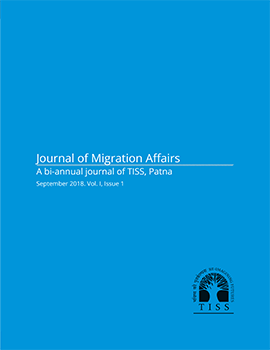©author(s)
Journal of Migration Affairs
Vol. II(1) : 141-142, September 2019
Pdf Issue: Book Review
Indian Migration and Empire: A Colonial Genealogy of the Modern State by Radhika Mongia, Ranikhet: Permanent Black, 2019; pp ix+ 230, Rs. 695.
While there has been a plethora of writing on the migration of indentured labour in recent years, what remained largely unexamined was the role of the state. Mongia addresses this gap by answering two important questions: how did states come to control migration, and what do these controls tell us about state formation and operation?
The state has been mostly assumed to be a given, an immutable entity obstructing migration. Regulation of migration is central to the conceptualisation of the ‘modern state’. Mongia questions this ahistorical, static understanding of the state. Migration scholarship, she argues, has seen ‘nation, nationality and the nation-state’ as ‘both the starting and end points of analysis’ (p.4). Even transnationalism, a concept seeking to overcome methodological nationalism, has its limitations. Mongia argues that migration scholarship continues to suffer from ‘methodological statism’ – a position that naturalises the state (p.5). How porous borders became rigid, and states came to control migration, are questions that need inquiry. Regulation of migration became a way of reaffirming state sovereignty, keeping populations and territories fixed, and determining citizenship. Migration, according to Mongia, is not a consequence or by-product, but an important site of state formation.
Mongia focuses on the ‘practices, techniques and institutions’ rather than the state as a coherent entity (p.7). She seeks to bring to light the entanglements between the colonial state and the modern state, rather than highlight their distinct features as done by otherscholars.
Migration scholarship largely uses state and legal categories to understand migration: ‘free’ and ‘unfree’ being one of the most important distinctions. She rightly points to this distinction being limiting and hampering the understanding of the state’s role.
Mongia explores both, the state’s logic of facilitation and the logic of constraint, while dealing with emigration. She points out how seemingly disconnected events – abolition of slavery, colonial rule in India and political economy in Britain – were related. Replacement of slavery with ‘free’ labour was linked to ideas of liberalism and the civilising mission of colonialism.
The understanding of contracts underwent a change and that change became an indicator of freedom. Consent became an inextricable part of the contract. Enquiry committees were set up in India and Mauritius to look into the conditions laid down in labour contracts, in the face of complaints of exploitation. There were disagreements among members, but they agreed that the problem lay with the natives – emigrants and recruiters. The contract itself, as a mechanism producing dualities of freedom/unfreedom and consent/coercion, escaped attention. Indentured migration was a paradoxical situation where the state regulated ‘free’ migration under the logic of facilitation.
An increase in the regulation of migration took place at the same time when the state was expanding. Using Foucauldian understanding of power, Mongia examines how disciplinary power was exercised through constant surveillance and supervision, and increased bureaucratic reporting at all levels. Disciplinary power and sovereign power complemented each other. In 1984, there were seven pages of rules. This went up to 103 pages of rules and fifty-nine forms in 1993. Abuse and exploitation continued to remained unaddressed; military- style rules of discipline, codes of conduct and procedures were established for even the smallest of things – kinds of lighting, the kind of metals to be used on ships, the schedule of emigrants, how much time they should spend on the deck etc. Migration was micromanaged by the state. Control over the migrant’s body was exercised – its functioning, health, hygiene, disease and diet were all minutely monitored. ‘Processes of examination and surveillance pervaded every aspect of the apparatus of Indian migration control…’ (p.65)
Mongia also examines movements that were unregulated by the state and came to ‘generate deep racial anxieties in white-settler colonies’ (p.84), which were resolved in a piece-meal fashion. She examines how migration got linked to the nationalistic discourse and how migration contributes to nationality as a territorial attachment.
She then examines how Canada tried to prevent Indian immigration to Canada without explicitly stating the racist logic behind it. They gave pretexts of an unsuitable climate, uncertainties in work and the possibility of destitution, and when nothing seemed to work, imposed illogical conditions on immigrants. The passport, a document which enables movement and serves as an identity proof, now served as an instrument for restricting movement along racial lines.
This book is academically rigorous, useful for historians and political scientists, and of immense relevance to migration scholars. Mongia questions the clear-cut division between the colonial state and the modern state, highlighting their entanglements. In the process of studying migration and state formation, we find that the surveillance technologies employed by the state also tell us how it viewed its subjects – dangerous, ignorant, unruly, stupid and always needing patronising and disciplining. The book overlooks internal migration completely. While that is not the focus of her book, and Mongia can be excused for not examining it, an exploration of the treatment of internal migrants by the colonial state as well as the modern state would have opened up many more doors.


Leave a Comment
Comments are moderated and will be published only if found appropriate. Comments may take some time to appear.
Your email address will not be published. Required fields are marked with *